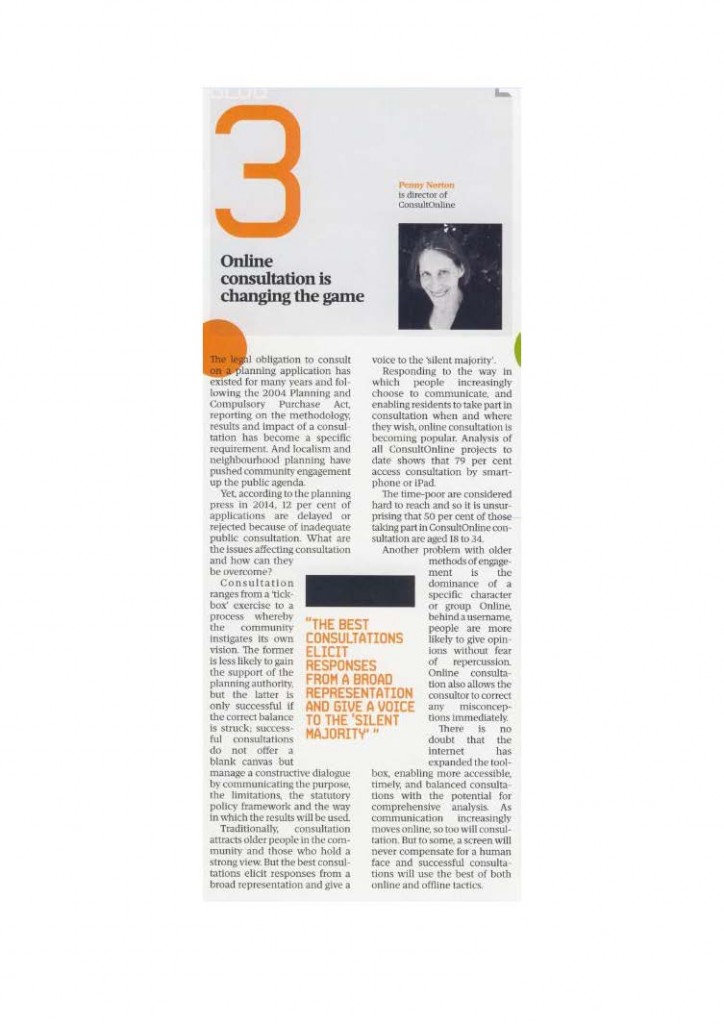The legal obligation to consult on a planning application has existed for many years and following the 2004 Planning and Compulsory Purchase Act, reporting on the methodology, results and impact of a consultation has become a specific requirement. Simultaneously, localism and neighbourhood planning – not to mention an enhanced media profile for the profession – have pushed community engagement up the public agenda.
Yet 12% planning applications are delayed or rejected because of inadequate public consultation. So why is this, what are the issues affecting consultation and how can they be overcome?
Consultation ranges from a ‘tick box’ exercise to a process whereby the community instigates its own vision. I would expect the former is less likely to gain the support of the planning authority. However, the latter is only successful if the correct balance is stuck: in my experience successful consultations do not offer a blank canvas but manage a constructive dialogue by communicating the purpose, the limitations, the statutory policy framework and the way in which the results will be used.
Consultation fatigue – a reflection of our increasingly busy lives and constant requests for feedback – is a significant hurdle. Traditionally consultation attracts older members of the community and those who hold a very strong view. But the best consultations elicit responses from a broad representation and gives a voice to the ‘silent majority’.
Responding to the way in which people increasingly choose to communicate, and enabling residents to take part in consultation when and where they wish, online consultation is becoming popular. Analysis of all ConsultOnline projects to date reveals that 79% access consultation by smart phone or iPad, and that many do so late at night.
Much has been written on targeting traditionally ‘hard to reach groups’. The ‘time-poor’ are increasingly considered hard to reach and so it is unsurprising that 50% of those taking part in ConsultOnline consultation are aged 18-34 – young parents and commuters feature highly among our users. A website also enables participation as a result of its physical accessibility, text-to speech, variable font sizes, and ‘translations’ of complex technical documents.
Another problem with traditional methods of engagement is the dominance of a specific character or group. Online, particularly behind the veil of a username, individuals are more likely to voice their opinions without fear of repercussions.
The day of informing the public on a development proposal and collecting in results at the end of the process is over: today’s consultations are about ongoing engagement. Online consultation is fast and responsive, enabling the consultor to become aware of, to understand, and to correct any misconceptions immediately. But timelines should not be shortened as a result: time must be taken to target stakeholders, both initially and throughout the process.
There is no single method of consultation that will guarantee a smooth passage through planning committee. But there is no doubt that the internet has expanded the toolbox of consultation techniques, enabling more accessible, timely, and balanced consultations with the potential for very comprehensive analysis and reporting. Currently 60m UK individuals use the internet regularly and the figure is increasing by 1.5m each year. As communication increasingly moves online, so too will consultation. But to some, a screen will never compensate for a human face and successful consultations will utilize the best and most appropriate of both online and offline tactics.
First published in The Planner, April 2015.

Penny Norton is the director of PNPR and founder of ConsultOnline. Her book Public Consultation and Community Involvement in Planning: a twenty-first century guide is widely available, and two further books Promoting Property: insight, experience and best practice and Communicating Construction: insight, experience and best practice will be published by Routledge in 2020.